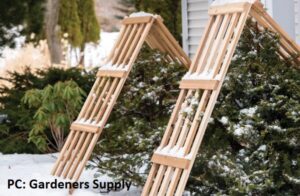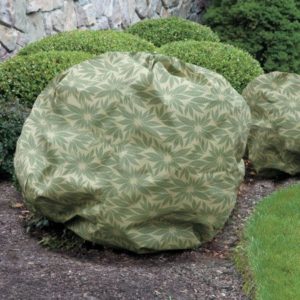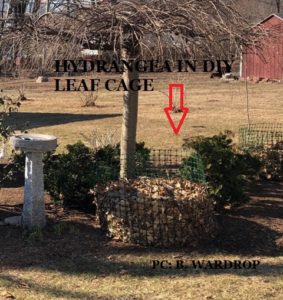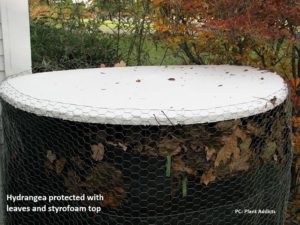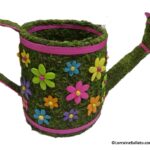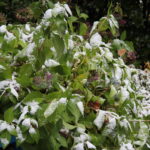We have had rain of biblical proportions the last few weeks, making my soil nice and soft: perfect for preparing hydrangeas for winter. Specifically, it’s time to think about insulating susceptible bigleaf (macrophylla) and mountain (serrata) hydrangeas. Those that aren’t planted in protected locations as I described in my other blog posts, HERE and HERE need a little help if the flower buds are to have their best chance of making it through the coming winter. It’s a hard lesson we learned this past season as many plants were killed to the ground.
MOVE THINGS AROUND
First things first…if you can move your plant to a protected spot, do it now. It needs time to establish roots before the ground freezes (at least 6 weeks). If you can plant something with winter persistent foliage like an azalea, rhododendron, or conifer that will shield your hydrangea, do it now. Just watch out for future root competition for water.
So let’s get to this preparing your hydrangeas for winter business. Exactly what does this mean? SHRUB COVERS: something to safely shield the plants from ice and snow. Shrub covers can even give them a few degrees of insulation.
PREPARING HYDRANGEAS FOR WINTER WITH SHRUB COVERS
The objective of shrub covers is to make your plant think it lives in a warmer zone. You do this by shielding it from freezing and fluctuating temps that can blast the flower buds. We saw a lot of that this past winter. Of course, you need to wait until your plants have dropped all their leaves on their own before you can cover them. That leaf drop signals the plant is fully dormant and time for you to get busy.
Take the time after leaf drop to clean up the fallen leaves from the base of the plant. That small task will prevent lingering fungal spores from overwintering and reinfecting your plants next season. This is also a great time to add some mulch to keep moisture in and prevent the plant from heaving during warm spells you’re likely to have.
WHAT DOES A SHRUB COVER LOOK LIKE?
A-FRAME VERSION
A simple A-Frame made from discarded wood pallets is a popular DIY solution to prepare hydrangeas for winter. Lots of stores pile them up at their back door which you can salvage. Many gardeners like to build one on their own. DIY plans and ideas are all over the internet.
You can leave the A-Frame bare to simply shunt off snow and ice. However, for colder areas the A-frame makes a great base to drape a tarp or insulating cover. If you do that, make sure you secure the tarp or cover against the weather with string or a bungee cord.
UNFRAMED DRAPE VERSION
Many gardeners prepare their hydrangeas for winter with an unframed drape. It’s held by the stems of the plant. It’s usually tethered at the base. Here’s one available at several online shopping sites:
PREPARING HYDRANGEAS FOR WINTER WITH A DIY CAGE
The winter preparation for hydrangeas I see most often is a DIY version made with chicken wire and a few stakes. You build a cage larger than your plant and then stuff the opening with leaves, straw, pine needles, etc. You need to be sure you get the insulating materials down and around the bare stems. This takes a bit of care as you want to avoid damaging the tips and stems where the sleeping buds lie.
INSULATING THE CAGE
Depending on where you live and where your plant is sited, you may want to insulate the outside of the cage. Bubble wrap is one such useful material.
Also note that your packing materials will settle during the winter. To deal with that many gardeners secure a cover over the top of the structure. You can cut a piece of Styrofoam (from craft stores) slightly larger than the top of the cage. Fit it above the cage and secure it to the chicken wire with twisties or bungee cords. Otherwise, heavy snow and rain will weigh the cover down and it will crush your plant. You can also use plywood or scrap lumber for this top. Make sure it’s not too heavy for the chicken wire to hold it up. Barring that, you can keep an extra supply of bagged leaves at the ready to top off your masterpiece from time to time.
THE NEED TO PREPARE OTHER HYDRANGEAS FOR WINTER
Many times I get asked about the need to protect other old wood flowering hydrangeas for winter, e.g., oak leaf and climbing hydrangeas. First of all, these plants are traditionally much harder to wrap. I have no clue how to wrap a climbing hydrangea – unless it is a new, small plant. And oak leaf hydrangeas can be quite large.
You can use the same technique of shrub covers. But here’s the good news: you don’t have to worry about these plants unless you grow them in a zone colder than their hardiness rating. In my 30+ years at this zone 5B home, those two varieties never failed to flower despite some significantly frigid winters and unseasonal springs. They have always come through.
WAITING TO PREPARE HYDRANGEAS FOR WINTER
Taking the need for dormancy into account, it may be too early in your part of the country to install these covers. But it’s not too early to get those shrub covers lined up. By the time you need them, you might not have enough time to get it all done.
Let the plants harden off over the next few weeks while you get things ready. But don’t wait for the last minute when time is short to get things organized for installation. There’s no way to tell when suppliers will run out and how much time you have to get yourself set up for this task. You can be ready to spring into action more quickly when you have your covers all planned out and ready to go. Plus it is more pleasant to work outside before the temps really plunge.
I cover the subject of winter protection in my award winning international best selling book, Success With Hydrangeas, A Gardener’s Guide. You can order a signed copy HERE. It makes a great gift for the gardener in your life.
UPCOMING PRESENTATIONS
I will be speaking in person at the Greenwich Botanical Center on Wednesday, October 25, at 10 a.m. The topic is Shrubs, the Backbone of the Garden.
The meeting will be held at the Greenwich Botanical Center located at 130 Bible Street, Cos Cob, Connecticut 06807, 203-869-9242, info@greenwichbotanicalcenter.org. The cost for GBC members is $10. The non-member charge is $20.
Further down the road, I am booking presentations for 2024 and beyond. The good news is that geography becomes irrelevant with virtual talks. I can easily deliver your favorite gardening topics to any location. Just click HERE to start the ball rolling to have me present to your group. And if any of the upcoming dates I have are public (very few are), I will post it on the calendar page of this site.
Lastly, if you want to read any of my writing aside from this blog, you can find me at Connecticut Gardener.
Thanks for reading.
6 Secrets for Stunning Hydrangea Flowers
Get my FREE mini-guide with 6 fool-proof tips showing how to grow hydrangeas that produce the most amazing flowers.
No spam - I promise!
